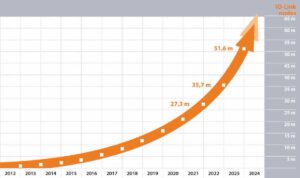 Based on the evaluation of the notary statistics for IO-Link, it can be said that the IO-Link standard has arrived on the market. A significant contribution to this is the standardized parameter model (IODD), which is reliably integrated in all tools. This means that all IO-Link devices are described according to the same rules and can be parameterized, whereby the process data is clearly structured. A key success factor is that more than 170 companies now store their IODDs on the IODDfinder, from which the tools automatically download the correct IODD for the devices found. This means that more than 14,000 IODDs and almost 30,000 devices can now be accessed very conveniently. The launch of the IODDfinder can certainly be described as one of the biggest and most courageous steps taken by the IO-Link community, as there was previously no such central storage of description files and the associated manufacturer declarations across all manufacturers. The IODDfinder can also be seen as a quality tool, as only tested devices can be stored here.
Based on the evaluation of the notary statistics for IO-Link, it can be said that the IO-Link standard has arrived on the market. A significant contribution to this is the standardized parameter model (IODD), which is reliably integrated in all tools. This means that all IO-Link devices are described according to the same rules and can be parameterized, whereby the process data is clearly structured. A key success factor is that more than 170 companies now store their IODDs on the IODDfinder, from which the tools automatically download the correct IODD for the devices found. This means that more than 14,000 IODDs and almost 30,000 devices can now be accessed very conveniently. The launch of the IODDfinder can certainly be described as one of the biggest and most courageous steps taken by the IO-Link community, as there was previously no such central storage of description files and the associated manufacturer declarations across all manufacturers. The IODDfinder can also be seen as a quality tool, as only tested devices can be stored here.
To also create a visible quality feature on the IO-Link gateway/master side, the IO-Link community launched the ACL (Approved Component List) in Spring 2024, which can be viewed at any time on the IO-Link.com website. Another advantage is the variety of different IO-Link devices now available on the market and their independence from manufacturers and bus systems. This means that, in addition to industrial automation, other sectors are also using the IO-Link system and thus expanding the system’s possibilities. These include the food and beverage and mobile machinery sectors.
The independence of bus systems is reflected in the numerous mappings of IO-Link data, whereby it can be clearly stated that the current mapping of IO-Link in PROFINET is considered the best mapping from a technical perspective. There are also mappings for JSON and OPC UA for the IIoT connection, which also contributes to the spread of IO-Link. To continue to meet the demands of the market, the IO-Link community, like other systems, is following the path of annual maintenance updates of the system specifications in order to continuously improve the quality of the standard and consistently map future extensions. The new IO-Link version 1.1.4 has been approved and is the first maintenance release of the IO-Link specifications. In this release, the change requests made to the respective specifications have been considered, with the premise of not changing the functionality of IO-Link, but rather eliminating errors and ambiguities.
IO-Link also contributes to the miniaturization of intelligent actuators and sensors, so that many devices now have more than just one process value. However, this also leads to new challenges that are reflected in the creation of profiles, such as the smart sensor profile. This development shows that we in the IO-Link community want to help shape the future of IO-Link in order to do justice to user benefits and respond to users’ comments and wishes. This means that IO-Link is and will remain a key technology in modern automation.

 Joachim Uffelmann,
Joachim Uffelmann,